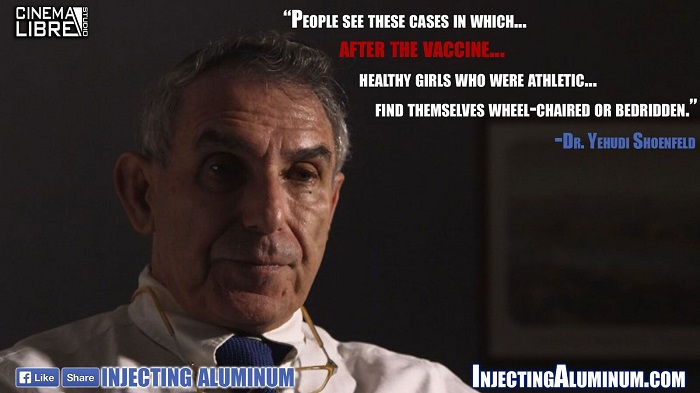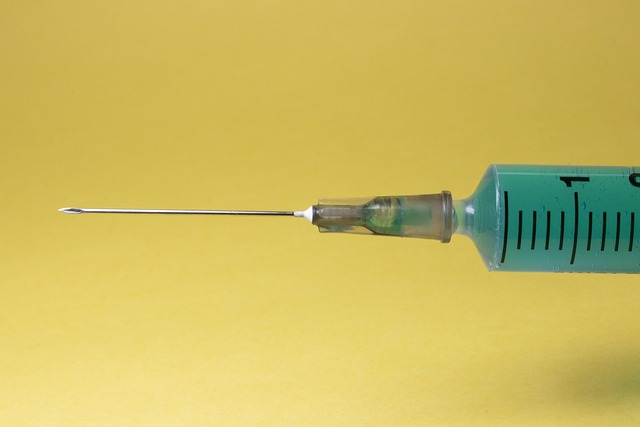Hope Spells Help Our People Exist
Fact One: Aluminum is present in U.S. childhood vaccines that prevent hepatitis A, hepatitis B, diphtheria-tetanuspertussis (DTaP, Tdap), Haemophilus influenzae type b (Hib), human papillomavirus (HPV) and pneumococcus infection
For someone always skeptical of big money-big business tied to anything in the realm of medicine or science in general, I have lifted myself way beyond hope when it comes to any amount of efficacy in medicine or all the other nodes tied to our modern industrial-postindustrial world.
The vaccination debate is a misnomer in itself, since the debate is really an attack on anyone who dares question the science and chemistry and genetic engineering of the vaccine industry, an industry that plows through so many of our rights as citizens, individuals and patients. We have states and school systems ordering people of all ages to submit to the needle.
A new film airing in May, Injecting Aluminum, looks at a specific aspect of the vaccine “debate” through what easily is the one giant Gordian knot metaphor of the entire vaccine injury and death history – the adjuvant aluminum hydroxide developed in the 1920s as the “best” optimizer of the immune response when injecting the disease.
The subtitle of 90-minute film by director Marie-Ange Poyet, How Toxic are Vaccines?, really takes the air out of the sails of the pro-vaccine-and-never-question-the-vaccinologist zealots. In fact, it’s the Gordian knot we can cut away: disentangling an impossible knot but cutting that damned thing, or finding a loophole through creative and robust outside the box thinking:
Turn him to any cause of policy,
The Gordian Knot of it he will unloose,
Familiar as his garter
— Shakespeare, Henry V, Act 1 Scene 1. 45–47
The director says things about the power of film, or the limits of documentaries, that I too voice:
“I don’t think movies can change things,” Marie-Ange Poyet says: “They bring new information, they contribute to change, but they don’t carry themselves the ability to deeply shake the system in which we are.”
She states that if the film can educate the public and rally around the “real drama” of those lives affected by aluminum salts in vaccines, then Marie-Ange would be satisfied.
The commitment of citizens is the only way things will change. I hope this citizen-driven film can be a step in that direction.
Storytelling Straight in the Eye
Viewing the interviews in this documentary for 90 minutes, I came to the realization that the story of the wounded and chronically ill — because of their bodies’ reaction to the aluminum — is the taproot of this film’s blossoming.
We have some heavy players in medicine and some compelling victims of the vaccines, as well as intrepid journalists. More than 16 powerful voices from a myriad of perspectives give shape to the film. And this is a film of a special order – the voices are captured in straightforward narrative style. No asides or typical documentary bells and whistles. No graphics, no tours of the drug manufacturers research facilities, no laboratory microscopic images, no up close and personal looks at rehabilitation.
Just interviews are captured, as if this is an inquest on the very substance that is at the center of this disease the French medical and research community discovered in the 1990s – Macrophagic Myofascitis, or MMF. It’s a very simple and to the point look at one element that is toxic to the human body, and an element tied to MS and Alzheimer’s and here now, MMF, which has destroyed young people’s ability to lead regular lives.
Anti-Aluminum isn’t Anti-Vaccine: Precaution Over Profits
Some of the heavy-hitters are MDs like Romain Gherardi and Jerome Authier, professor Christopher Exley, member of the European Parlimante Michele Rivasi, Le Monde journalist Stephane Foucart, and President of E3M (Entraide aux Malades of Myofascite to Macrophages) Didier Lambert.
The NGO E3M and victims of MMF support scientific research to buttress their campaign to have aluminum removed from vaccines. Lambert is currently on disability, which is a state of survival 80 percent of the members of the association E3M share.
He is outspoken and on a mission of protecting his country and others by advocating taking aluminum out of vaccines, “without calling into question the very principle of vaccination.”
The simple aim is to reverse the felonious push to keep aluminum in vaccines by going back to the gold standard of the Precautionary Principle. This is a simple oath and operating system science that scientists (and all sectors of civilization) ought to abide by, but also embrace before any chemical, product, service or process is pushed onto us. Where money and profits and vast accumulation of power rides roughshod over our civilization, there rarely is a deep look at the unintended consequences or negative feedback loops.
It is easy to undergird the documentary with a proviso tied to the ideas of “first do no harm,” or, “better safe than sorry,” or, “an ounce of prevention is worth a pound of cure.” In the past 100 years, at least, Western Civilization has been moved by demonic ideas of profit tied to these aphorisms: “Nothing ventured, nothing gained” and, “Let the devil take the hindmost.”
Some of the film’s “stars” are folk like Dr. Exley, bioinorganic chemistry professor at University of Stirling, who has been for more than three decades researching “how the third most abundant element of the Earth’s crust, aluminum, is non-essential and largely inimical to life.”
Ironically, he investigates the most abundant element on Earth’s crust, silicon, and how it is almost devoid of biological function: “One possible function of silicon is to keep (aluminium) aluminum out of biota.”
Here, the Precautionary Principle with the help of Peter Montague :
The release and use of toxic substances, the exploitation of resources, and physical alterations of the environment have had substantial unintended consequences affecting human health and the environment. Some of these concerns are high rates of learning deficiencies, asthma, cancer, birth defects and species extinctions, along with global climate change, stratospheric ozone depletion and worldwide contamination with toxic substances and nuclear materials.
We believe existing environmental regulations and other decisions, particularly those based on risk assessment, have failed to protect adequately human health and the environment the larger system of which humans are but a part.
We believe there is compelling evidence that damage to humans and the worldwide environment is of such magnitude and seriousness that new principles for conducting human activities are necessary.
While we realize that human activities may involve hazards, people must proceed more carefully than has been the case in recent history. Corporations, government entities, organizations, communities, scientists and other individuals must adopt a precautionary approach to all human endeavors.
Therefore, it is necessary to implement the Precautionary Principle: When an activity raises threats of harm to human health or the environment, precautionary measures should be taken even if some cause and effect relationships are not fully established scientifically. In this context the proponent of an activity, rather than the public, should bear the burden of proof.
The process of applying the Precautionary Principle must be open, informed and democratic and must include potentially affected parties. It must also involve an examination of the full range of alternatives, including no action.
Mountains of Studies Indicting Aluminum Adjuvants
Compelling for me about the film is the detail both the citizens patients of MMF and the established biology, chemistry, immunology, medical experts lay out for the viewer. Exely is both trustworthy and compassionate, quirky and interesting. He is interviewed in his office with towers of research papers and journal articles behind him like many Leaning Towers of Pisa.
His scientific bent is on deep research, unclouded by some profit margin derived by selling the aluminum to labs and the manufacturing facilities and pharmaceuticals making billions on these vaccines.
He cites the common known fact that adjuvants in vaccines do not require clinical approve. The vaccine preparation does go through trials, so when the aluminum is put in vaccine, it is the vaccine that gets approved, not the aluminum or another adjuvant.
The articulate scientist knows the field of aluminum research. For instance, he states that he can’t say the cause of Alzheimer’s is aluminum, but aluminum does make Alzheimer’s worse, and aluminum does make Alzheimer’s occur at an earlier age. He goes on:
You have this fantasy of, I think it’s the World Health Organization, giving a safe limit for aluminum, and they say, as long as it’s low, one milligram per kilogram body weight per day, you’re safe. I asked them, how do you know that, when I don’t know it? I’ve been working on aluminum for 30 odd years, trying to understand it, you know this. I asked them for the details, how did you work this out, and who did it?
They have people that I call the aluminum ambassadors…Usually, good scientists all around the world, who are paid by the aluminum industry to say that aluminum is not a problem, but these are not individuals who work on aluminum. Most of them have absolutely no background in aluminum whatsoever. They are individuals, who for example, work on Alzheimer’s disease, and then they, whenever someone with the Alzheimer’s society, a major charity, asks for advice, they ask this well-known person in Alzheimer’s disease, what’s the role of aluminum? No, there’s nothing to worry about. They don’t ask me.
“It’s the Calcium Phosphate, Stupid, We Need!”
Fact Two: A small proportion of vaccinated people present with delayed onset of diffuse myalgia, chronic fatigue and cognitive dysfunction, and exhibit very long-term persistence of aluminum-loaded macrophages at site of previous intra-muscular (I.M.) immunization, forming a granulomatous lesion called Macrophagic Myofasciitis (MMF). Clinical symptoms associated with MMF are paradigmatic of the recently delineated “autoimmune/ inflammatory syndrome induced by adjuvants” (ASIA)
Here we have aluminum hydroxide dating back to 1927. The same compound used in vaccines in 2018. Yet, in 1974, the Insitut Pasteur developed calcium-phosphate adjuvant, and the president of the French vaccination committee admitted that the calcium phosphate adjuvant was no less effective than aluminum salts. That adjuvant could be brought back. It takes a political decision. “Then our vaccines would be safe,” says Didier Lambert.
Aluminum salts are identified as neurotoxic by many health authorities and organizations. Count Alzheimer’s, Parkinson’s, Crown’s, Sarcoidosis, development of allergies, cases of chronic fatigue, multiple sclerosis, amyotrophic lateral sclerosis, autism and many more as the unintended side effects of aluminum, according to Professor Exley and many more.
The evidence in the documentary mounts minute by minute, and the interviews are clear but not charged with emotions or with a music track overlay.
Professor Jérôme Authier, a neurologist and coordinator of the Centre of Reference for Neuromuscular Diseases at H. Mondor Hospital, states the aluminum stays at the injection site for months, and migrates to the liver, spleen and brain. He sees unique conditions/factors that slow down or speed up the migration:
• The injection site: faster migration if the injection is administrated by subcutaneously rather than intramuscularly
• Genetics: faster migration on some people more than others
• The dose: a moderate dose of aluminum adjuvant forms small aggregates of particle. It migrates in the brain faster than a significant dose which in turn forms larger aggregates, long stored in the periphery.
• It also accumulates in the lymph nodes and spleen, which are organs related to the immune system.
• Patients with Macrophagic Myofasciitis (MMF)suffer from cognitive disorders such as brain dysfunction, associated with persistence extended aluminum in their body at the injection site.
Even the so-called godfather of autoimmunology, Dr. Yehuda Shoenfeld, was brought forth by Poyet to discuss aluminum adjuvant; and he lists MMF as one of the Autoimmune/inflammatory Syndromes Adjuvants, also known as ASIA. Shoenfeld founded the Centre for Autoimmune Diseases in Israel and has written 25 books about autoimmunity.
The Israeli doctor is clear about this injecting aluminum question: How Toxic Are Our Vaccines?
Aluminum is foreign to our body. It is one of strongest adjuvants. It can cause toxicity to the brain, ovaries and the immune system. We should avoid it from our lives.
Studying Cause and Effect in Vaccine Use, Ingredients and Frequency Makes Us Smart, Not Antivax
It is clear that researchers calling into question the prevailing “norm” or the current baseline, aluminum adjuvants, are called charlatans, and the media (paid for in large measure by Big Pharma) go on the attack. But, again, the godfather, Shoenfeld, submits a counter to that propaganda:
I have to say that, for my experience, both in Israel, as well as in Denmark, for instance, one of the countries where we have a large number of subjects who suffer the severe side effect, especially from the HPV. People see these cases in which, immediately after the vaccine, or very close to the vaccine, healthy girls who were apparently athletic, and suddenly, they find themselves wheel chaired or bed ridden.
The issue of primary ovarian failure, which means young women can’t get pregnant, and the reason is that the aluminum destroyed or affected the maturation of the eggs in the ovaries. Shoenfeld:
It [ovarian failure] has been reported in several cases, it’s still under reported, because many of those girls are on contraceptive pills, and therefore, they delay the diagnosis only after they will stop or discontinue to take these contraceptive pills, but it has been shown that if you inject aluminum into mice, you destroy or you affect the maturation of the eggs in the ovaries.
Exley points out that aluminum is a “silent visitor.” We do not get the sudden sickness from aluminum as we do lead, cyanide, or cadmium. It would take a huge amount of single exposure to cause immediate and profound ailments or even death. “Now, there is a proviso for that, an exception, and I believe the exception to that can be vaccination,” he states.
Oh No, Show Me the Money (again?)
The film exposes many aspects of why this 91-year-old aluminum salt is still in use. In addition, we find out why the French government isn’t doing anything to take aluminum out of vaccines. Think Sanofi, L’Oreal, and Nestle. We know the French multinational, Sanofi, is the world’s largest producer of vaccines. Ironically, the majority shareholder in that Titan of Vaccines is L’Oréal, which is the world’s largest cosmetics company. Now, following the tangled web of multinationals, we see that the principal shareholders of the cosmetics company L’Oreal is the Bettencourt family and Nestlé. Moreover, Nestlé is the world’s largest food-industry corporation.
Didier Lambert is blunt about the entanglement and special interests the corporations have, and the power they wield to control regulators and governments:
These three corporations have a special interest in aluminum. Sanofi uses aluminum in vaccines. L’Oréal uses it in cosmetics, and Nestlé, in food packaging, infant formula, etc. Note that the people who oppose the research by Drs. Gherardi and Authier are mainly financed by either Sanofi or the Bettencourt Foundation. Is that a coincidence?
Bunnies and then the Big Guns of Injecting Aluminum
Ironically, two German scientists in 1891 looked at aluminum, to see how it breaks down and dissolves in food and therefore was deemed toxic. To settle court cases, manufacturers of products aluminum were used as hired scientists on both sides of the argument. In 1908, Theodore Roosevelt appointed a commission to look into the safety of aluminum. The stakes were high, and those researchers incriminating aluminum had little funding, whereas the special interests backing aluminum eventually got the green light from a book two decades later written by a recognized scientist, Ernest Ellsworth Smith, that was biased and in favor of aluminum and omitted findings from other scientists showing aluminum was harmful.
The key study cited as the main reference on how the body absorbs the aluminum adjuvant in a vaccine was done in 1997. It was carried out by an American researcher named Richard Flarend and his co-author Stanley Hem. Their study involved two New Zealand white rabbits being injected with radioactive aluminum hydroxide. We are talking about 28 days of monitoring the elimination rate of radioactive aluminum through urine samples. Their findings? Elimination, 28 days after injection, was 6%. So 94% of the aluminum stayed in the animals’ bodies. Even with this scrawny one study, scientists still claim that it only takes a few weeks to eliminate aluminum injected into humans.
“Aluminum, Vaccines and the Two Rabbits” was the original title of this documentary in France. The director, Marie-Ange, did not go with that moniker:
In a nutshell, aluminum’s pharmacology is founded on a study based on two rabbits only. And their bones have been lost. That study lasted only 28 days. So, all what you hear about aluminum in vaccines is based on that incomplete work. We hear that the illnesses linked to aluminum are not dramatic, and it’s based on this study. It’s unbelievable. Since the vaccine market represents billions of dollars, we can say that the industry makes all this money thanks to these two rabbits. The original title of the film was a funny and dramatic wink to that story.
Those not winking are the big guns of the documentary are Professor Jérôme Authier, a neurologist and coordinator of the Center of Reference of neuromuscular diseases of the Henri Mondor Hospital, and Doctor Romain Gherardi, the Director of the French National Institute of Health and Medical Research. Gherardi has written more than 100 articles in refereed journals including topics tied to the physiopathology and therapeutics of adult neuromuscular diseases, as well as the cellular and molecular mechanisms of postnatal myogenesis and post-lesion regeneration.
Three sources stand out:
a. “Macrophagic myofasciitis lesions assess long-term persistence of vaccine-derived aluminum hydroxide in muscle” (Brain – 2001) by both Authier and Gherardi.
b. “Macrophagic myofasciitis: characterization and pathophysiology” ( Authier and Gherardi) .
c. Gherardi recently wrote a book about his experiences with aluminum and vaccines called, Toxic Story – Two or Three Embarrassing Truths about Vaccines and their Adjuvants.
Here is a compelling example of “throwing caution and verified facts to the wind” by Dr. Romain Gherardi:
“The guiltiest act is that once it has been pointed out that the aluminum persists for much longer than a month, that it remains in the immune system for many years, no watchdog agency sat up and said, ‘Stop. Back to the laboratory, guys.’ That should have been done in the early 2000s. And it was not. So we’re fifteen years late, in terms of the natural reaction elicited by the normal application of intellectual discipline.”
The entire case for aluminum adjuvants being safe is based on a 28-day rabbit study where the animals’ bones were “lost” by researchers. Hmm, bones are one area of the body that stores aluminum. The muscle that was injected was never examined.
This is not science as I have known it starting in 1975 as a marine biology major. We can’t determine whether the injected aluminum stayed at the muscle site. A 28-day study is for bean plant germination in kindergarten, not for vaccines. The aluminum adjuvant stays in the body for years, as the experts interviewed in the film attest. Amazingly, that the entire world of vaccinology takes this two New Zealand rabbit study from 20 years ago as proof of aluminum’s safety? This begs the question why this study has not been done over and over (maybe using some of the pro-aluminum adjuvant hominids as rabbits)?
“Not one of the experts who has studied the material we have compiled on MMF… and I am speaking of experts in their own capacity,” Gherardi states. “I’m not talking about … experts from public agency staff. I really mean independent experts we’ve asked to assess our research and give an opinion. Not one of them is free of strong connections to the vaccine industry. That’s all I can say.”
While the scientists and public policy people make compelling arguments around the toxicity of aluminum and the genetic variations some people possess, disallowing their bodies to “dissolve” mineralized aluminum, it’s also the individuals and married couples in the film that tell a story of life- changing medical issues that have plagued them, causing debilitating chronic pain and illness, necessitating complete life changes.
In the film: Laurent Lehrer and Marie-Christine Lehrer — patient with Macrophagic Myofascitis and wife; Nathalie Etienne and Patrice Nicosia — patient with Macrophagic Myofascitis and her partner; and Didier Lambert — patient with Macrophagic Myofascitis.
Their stories juxtaposed to the science and policy make this film compelling documentary viewing. We learn about all those genetic and cellular variations on a theme, including:
• autophagic xenophagy
• macrophage fusing with an organic killer, lysosome
• lysosome contains highly destructive enzymes and they only operate at acidic pH, so it has an acidic pH and the enzymes kill living organisms like bacteria
• They can also kill proteins or old mitochondria – any cellular waste material, but the pH, or acidity, is capable of corroding or dissolving mineral substances
In simpler terms, though, we know that some children and adults are more predisposed to vaccine injuries and adverse effects; we all are products of our epigenetics, when it comes to cancer, obesity, depression and thousands of other bio-physiological issues.
Again, the words of wisdom from Dr. Gherardi:
We know there are 34 genes which code for this highly complex machinery. So we looked for 109 variants; that is, genetic variations on each of these genes. They are ‘normal.’ That means the mutations do not cause disease in and of themselves. But they do predispose the system to dysfunctions. Of the 109 variants we checked out, we found 7 variants, located on six different genes, which are significantly found more frequently in patients with MMF, as compared to the general public. There are international consensus guidelines indicating normal ranges. It is interesting to note that these genetic mutations are cumulative. That is, our MMF patients present more than one variation. They have three, four, or five, and their effects probably combine. As a result, in a normal situation, when the macrophage just performs standard duties, it works fine.
If the job makes extra demands on the macrophage, most people overcome the difficulty, with a struggle. But a small minority will be totally unable to secrete the enzyme, and the toxin will remain. If 10, 20, or 25 vaccines are administered, regardless of genes, everyone will be overcome by the toxic burden. The cause of the system breakdown will be the toxicity itself.
The researchers and injured patient groups in France, USA and the other 20 countries looking at MMF and the connection to the adjuvant aluminum hydroxide have a universal battle to wage against the industries that make profit off of their mistakes, and who have utilized billions of dollars in marketing, which is another term for “covering up” or “falsifying data” or “burying the maimed or killed” or “denigrating truth-seekers and truth-tellers.”
Why is it that public and civil society proponents and social justice warriors are the ones crushed by the boulder of Sisyphus when it was the king of Corinth who was punished by the gods for “chronic deceitfulness by being compelled to roll an immense boulder up a hill, only to watch it roll back down, repeating this action forever.”
This film explores the truth around that deceit and maleficence and arrogance, and we the viewers have to decide who pays the ferryman, who pushes that boulder back up the hill of Capitalism. I sure as hell do not want to be responsible for the deceit and the outright felonies of the harbingers of capitalism at any cost.
We have too many examples in recent history around the failures of US medicine and the chemical and pharmaceutical industries to believe these people with the slick advertising departments and extra sleazy lobbyists and sales people.
We Need Your Help
Hormones Matter needs funding now. Our research funding was cut recently and because of our commitment to independent health research and journalism, unbiased by commercial interests, we allow minimal advertising on the site. That means all funding must come from you, our readers. Don’t let Hormones Matter die.



































